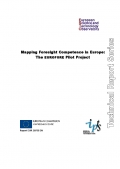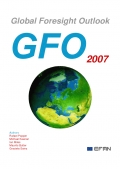Uploaded by Rafael Popper 5337 days ago Number of pages: 98 File's language: English Views: 3795
(Space monitoring of Earth Atmospheric Ozone)
“Space Monitoring of Earth Atmospheric Ozone” was written as part of the activities of the Asher Space Research Institute (ASRI), Technion, Israel Institute of Technology, intended for public education. It grew as a result of ASRI involvement in the development of an ozone-meter on board the Gurwin-Techsat Technion satellite, launched in July 1998 and still active in space.
The main mission of the ASRI is to advance science, technology and education in all space-related fields. The ASRI operates with a broad national perspective. It fosters interdisciplinary work and collaboration between Israeli researchers from all universities and agencies as well as industry. The ASRI has also established collaborative projects with other countries.
The ASRI was established in 1984. Its members are professors in several Technion faculties, and it has a technical staff of scientific experts in a variety of space-related fields. ASRI is the leading space research center in Israel and is also involved in the development of space systems based on advanced and innovative technologies.
As part of its activities, ASRI developed a technology demonstration micro satellite called Gurwin-Techsat. This project covered the conception, design, development, construction, test, launch and operation of a low Earth orbit satellite carrying a number of experimental scientific payloads. The purpose of this program was to demonstrate that smaller, high technology satellites could be rapidly developed and implemented for a fraction of the cost of heavier and more complicated satellites, and still be able to perform valuable space research. This project was based on a unique collaboration between Israel’s leading industrial organizations and ASRI.
Being designed as a multi-purpose platform suitable for space research, Gurwin-Techsat was equipped with six different devices to carry out on-board scientific experiments. All of the experiments have been repeatedly run during more than four years of satellite flight history. Of these six payload devices, the operation of the ozone-meter was one of the most successful. The ozone-meter was intended for measuring atmospheric ozone concentration. The ozone-meter flight test has enhanced the prospect of developing reliable, low-cost instruments for small satellites, necessary for carrying out such vital tasks as continuous ozone monitoring.
The study of ozone is important because of the effects of UV radiation on humans (e.g. skin cancer, eye cataracts, and deterioration of the immune system) and on agricultural systems (e.g., slower plant growth and reduced crop yield). Each spring, when the Sun rises over the Antarctic, chemical reactions involving man-made chlorine and bromine compounds occur in the stratosphere and destroy ozone, causing the "ozone hole". Total recovery of the ozone layer to levels observed before 1980 will take at least 50 years, and expected changes in climate, including a cooler stratosphere, could delay this process.
 State-of-art of sustainable innovation
State-of-art of sustainable innovation Sustainable Innovation Policy Advice
Sustainable Innovation Policy Advice CASI-F: Common Framework for the Assessment and Management of Sustainable Innovation
CASI-F: Common Framework for the Assessment and Management of Sustainable Innovation Your passport to the future!
Your passport to the future! The technology horizon: Preliminary review on technologies impacting the future health and social care workforce
The technology horizon: Preliminary review on technologies impacting the future health and social care workforce CfWI Future workforce matters - Issue 4
CfWI Future workforce matters - Issue 4 CfWI Future workforce matters - Issue 4
CfWI Future workforce matters - Issue 4 Science Foundation Ireland (SFI) Agenda 2020
Science Foundation Ireland (SFI) Agenda 2020 Quantitative Analysis of Technology Futures. Part I: Techniques, Contexts, and Organizations
Quantitative Analysis of Technology Futures. Part I: Techniques, Contexts, and Organizations myForesight: Malaysia's National Foresight Magazine (2nd Edition)
myForesight: Malaysia's National Foresight Magazine (2nd Edition) CfWI Future workforce matters - Issue 3
CfWI Future workforce matters - Issue 3 CfWI Future workforce matters - Issue 2
CfWI Future workforce matters - Issue 2 CfWI Future workforce matters - Issue 1
CfWI Future workforce matters - Issue 1 New Horizon Scanning Concepts, Practices and Systems
New Horizon Scanning Concepts, Practices and Systems KORANET Policy Foresight Workshop in Vienna/Austria
KORANET Policy Foresight Workshop in Vienna/Austria The Use of Strategic Intelligence and Horizon Scanning
The Use of Strategic Intelligence and Horizon Scanning iKnow ERA Toolkit (2011)
iKnow ERA Toolkit (2011) iKnow National Studies (2011)
iKnow National Studies (2011) iKnow Policy Alerts (2011)
iKnow Policy Alerts (2011) iKnow Interviews (2011)
iKnow Interviews (2011) iKnow Conference - Brussels, 27-28 October 2011
iKnow Conference - Brussels, 27-28 October 2011 Mapping Foresight Competence in Europe: The EUROFORE Pilot Project
Mapping Foresight Competence in Europe: The EUROFORE Pilot Project GFO 2007 - Global Foresight Outlook
GFO 2007 - Global Foresight Outlook OZONE: SPACE VISION
OZONE: SPACE VISION
iKNOW has been featured in the media and several research projects:
DIE ZEIT (Germany), Financial Times (Germany), El Heraldo (Colombia), Prospective Foresight Network (France), Nationalencyklopedin (Sweden), EFP - European Foresight Platform (EC), EULAKS - European Union & Latin America Knowledge Society (EC), CfWI - Centre for Workforce Intellience (UK), INFU - Innovation Futures (EC), Towards A Future Internet (EC), dstl - Defence S&T Laboratory (UK), EFSA - European Food Safety Agency (EU), Malaysia Foresight Programme (Malaysia), Bulletins Electroniques more...
